The global dialysis water filters market, valued at USD 671 million in 2025, is projected to expand steadily to USD 1,083 million by 2035, growing at a CAGR of 4.9%. A year-on-year (YoY) analysis highlights how the industry evolves in a phased yet consistent manner across the forecast horizon. Between 2025 and 2026, the dialysis water filters market is expected to cross USD 700 million, supported by rising installation of reverse osmosis and ultrafiltration units in hospital networks. YoY growth during this early stage is estimated to remain close to 4.8% as providers prioritize compliance with ultrapure water standards for dialysis applications. From 2027 to 2028, the dialysis water filters market momentum is expected to accelerate slightly as home dialysis programs and independent nephrology centers expand their treatment capacity. At this point, YoY growth remains stable between 4.9% and 5%, indicating a balance between rising patient demand and equipment affordability. By 2030, the industry is projected to touch USD 844 million, completing the first half of the forecast period with 42% of the decade’s expansion realized.
In the latter half, from 2031 to 2032, the YoY growth is forecast to strengthen as dialysis care becomes more decentralized, driven by investments in outpatient facilities and specialized clinics. This period should add approximately USD 40–45 million annually, reflecting continued upgrades in endotoxin removal technologies and multi-stage treatment systems. By 2033, with broader penetration of integrated platforms across both developed and emerging regions, annual growth sustains close to 5%, pushing the dialysis water filters market toward USD 1,000 million. The final two years, 2034 and 2035, represent a critical consolidation phase, with YoY additions of nearly USD 40 million annually, bringing the dialysis water filters market to USD 1,083 million by the end of the forecast horizon. Growth during this stage reflects maturity in adoption, where advanced bacterial filtration and long-term operational compatibility become baseline expectations across treatment environments.
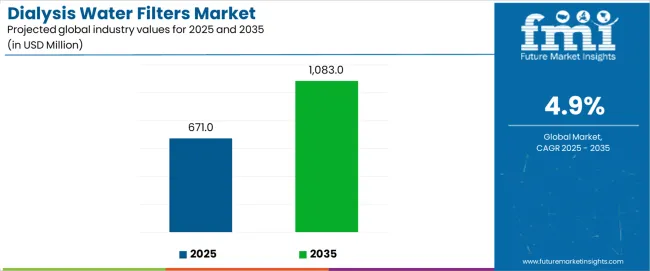
The dialysis water filters market demonstrates distinct growth phases with varying market characteristics and competitive dynamics. Between 2025 and 2030, the dialysis water filters market progresses through its advanced purification adoption phase, expanding from USD 671 million to USD 844 million with steady annual increments averaging 4.7% growth. This period showcases the transition from basic filtration systems to comprehensive multi-barrier platforms with enhanced contaminant removal and integrated monitoring becoming mainstream features.
The 2025-2030 phase adds USD 173 million to market value, representing 42% of total decade expansion. Market maturation factors include standardization of water quality protocols, declining equipment costs for high-performance systems, and increasing provider awareness of ultrapure water benefits reaching 80-85% effectiveness in dialysis treatment applications. Competitive landscape evolution during this period features established manufacturers like Nephros and Evoqua expanding their technology portfolios while new entrants focus on specialized membrane innovations and enhanced bacterial filtration technology.
From 2030 to 2035, market dynamics shift toward comprehensive integration and multi-facility deployment, with growth accelerating from USD 844 million to USD 1,083 million, adding USD 239 million or 58% of total expansion. This phase transition logic centers on universal high-performance systems, integration with automated dialysis equipment, and deployment across diverse treatment scenarios, becoming standard rather than specialized purification formats. The competitive environment matures with focus shifting from basic filtration to comprehensive water quality management and compatibility with modern dialysis treatment protocols.
| Metric | Value |
|---|---|
| Market Value (2025) | USD 671 million |
| Market Forecast (2035) | USD 1,083 million |
| Growth Rate | 4.90% CAGR |
| Leading Technology Type | Reverse Osmosis (RO) Systems |
| Primary Application | Hospital Segment |
The dialysis water filters market demonstrates strong fundamentals with reverse osmosis systems capturing a dominant share through superior purification capabilities and proven clinical performance. Hospital applications drive primary demand, supported by increasing dialysis patient populations and enhanced water quality management requirements. Geographic expansion remains concentrated in developed markets with established dialysis infrastructure, while emerging economies show accelerating adoption rates driven by healthcare modernization projects and rising chronic kidney disease prevalence.
The dialysis water filters market represents a compelling intersection of renal care advancement, water treatment innovation, and clinical quality optimization. With robust growth projected from USD 671 million in 2025 to USD 1,083 million by 2035 at a 4.90% CAGR, this market is driven by increasing chronic kidney disease prevalence, dialysis center expansion trends, and healthcare demand for reliable water purification systems.
The dialysis water filters market's expansion reflects a fundamental shift in how dialysis facilities and healthcare providers approach water quality infrastructure. Strong growth opportunities exist across diverse applications, from hospital dialysis units requiring clinical-grade purification to home dialysis programs demanding compact, reliable solutions. Geographic expansion is particularly pronounced in Asia-Pacific markets, led by China (6.6% CAGR) and India (6.1% CAGR), while established markets in North America and Europe drive innovation and specialized segment development.
The dominance of reverse osmosis systems and hospital applications underscores the importance of proven filtration technology and clinical reliability in driving adoption. Water quality standards and regulatory compliance remain key challenges, creating opportunities for companies that can deliver consistent performance while maintaining cost efficiency.
Market expansion rests on three fundamental shifts driving adoption across healthcare and clinical sectors. Chronic kidney disease prevalence creates compelling advantages through dialysis water filter systems that provide comprehensive contaminant removal with clinical-grade purification, enabling healthcare facilities to maintain treatment safety standards and ensure optimal patient outcomes while meeting regulatory compliance requirements and justifying investment over basic filtration methods. Healthcare facility modernization accelerates as hospitals and clinics worldwide seek reliable water treatment systems that deliver clinical excellence directly to dialysis operations, enabling cost reduction that aligns with healthcare management expectations and maximizes treatment quality productivity. Aging population demographics drive adoption from healthcare providers requiring advanced purification solutions that maximize contaminant removal while maintaining ultrapure water standards during treatment preparation and delivery operations.
The growth faces headwinds from equipment cost variations that differ across technology suppliers regarding pricing stability and installation complexity, potentially limiting adoption consistency in budget-constrained healthcare categories. Regulatory compliance also persists regarding water quality standards and clinical validation requirements that may increase complexity standards in markets with demanding healthcare protocols.
Primary Classification: The dialysis water filters market segments by technology type into Reverse Osmosis (RO) Systems, Ultrafiltration (UF) Units, Carbon Filtration Systems, and Deionization Units, representing the evolution from basic water treatment to advanced multi-stage purification for comprehensive clinical water quality management.
Secondary Breakdown: Application segmentation divides the dialysis water filters market into hospital, clinic, home dialysis, ambulatory surgical centers, and specialty treatment facilities, reflecting distinct requirements for purification capacity, water quality specifications, and clinical performance standards.
Regional Classification: Geographic distribution covers North America, Europe, Asia Pacific, Latin America, and the Middle East & Africa, with developed markets leading clinical innovation while emerging economies show accelerating growth patterns driven by healthcare infrastructure development programs.
The segmentation structure reveals technology progression from standard filtration systems toward integrated multi-barrier platforms with enhanced purification and monitoring capabilities, while application diversity spans from large hospital operations to home-based treatments requiring comprehensive water quality management and clinical-grade purification solutions.
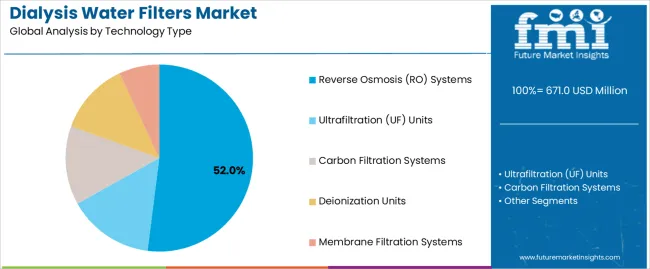
Reverse osmosis (RO) systems segment is estimated to account for 52% of the dialysis water filters market share in 2025. The segment's leading position stems from its fundamental role as a critical component in clinical water purification applications and its extensive use across multiple hospital and clinic sectors. RO systems' dominance is attributed to their superior contaminant removal capabilities, including excellent bacterial filtration, endotoxin elimination, and comprehensive ionic removal that make them indispensable for dialysis treatment operations.
Market Position: Reverse osmosis systems command the leading position in the dialysis water filters market through advanced membrane technologies, including comprehensive multi-stage processing, automated monitoring capabilities, and reliable clinical performance that enable healthcare providers to deploy purification solutions across diverse treatment environments.
Value Drivers: The segment benefits from clinical preference for proven purification technologies that provide exceptional water quality without requiring premium operational costs. Efficient treatment processes enable deployment in hospital dialysis units, outpatient clinics, and home dialysis applications where clinical reliability and regulatory compliance represent critical selection requirements.
Competitive Advantages: RO systems differentiate through superior contaminant removal, proven clinical performance, and compatibility with standard dialysis equipment that enhance treatment safety while maintaining economical operational profiles suitable for diverse healthcare applications.
Key market characteristics:
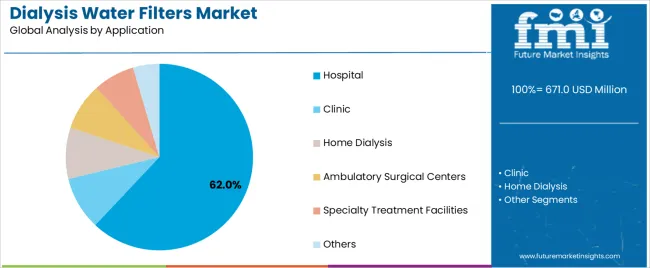
Hospital segment is projected to hold 62% of the dialysis water filters market share in 2025. The segment's market leadership is driven by the extensive use of dialysis water filters in hospital-based dialysis units, nephrology departments, intensive care units, and specialized renal treatment centers, where water purification systems serve as both a clinical necessity and safety requirement. The hospital sector's consistent demand for reliable water treatment supports the segment's dominant position.
Market Context: Hospital applications dominate the dialysis water filters market due to widespread adoption of clinical-grade water systems and increasing focus on patient safety, treatment efficacy, and regulatory compliance that enhance healthcare delivery while maintaining clinical standards.
Appeal Factors: Healthcare facilities prioritize treatment reliability, regulatory compliance, and integration with existing dialysis infrastructure that enable coordinated deployment across multiple clinical needs. The segment benefits from substantial patient population growth and healthcare modernization that emphasize reliable purification systems for dialysis applications.
Growth Drivers: Healthcare quality initiatives incorporate dialysis water filters as standard components for patient safety and treatment efficacy programs. At the same time, clinical excellence initiatives are increasing demand for premium features that comply with healthcare standards and enhance treatment outcomes.
Market Challenges: Equipment cost considerations and maintenance complexity may limit deployment flexibility in budget-constrained healthcare markets or regions with varying regulatory requirements.
Application dynamics include:
Growth Accelerators: Chronic kidney disease prevalence drives primary adoption as dialysis water filter systems provide exceptional purification capabilities that enable clinical treatment without contamination risk, supporting patient safety improvement and treatment efficacy that require reliable filtration formats. Aging population demographics accelerate market expansion as healthcare facilities seek advanced water treatment solutions that maintain clinical standards during dialysis operations while enhancing treatment safety through comprehensive contaminant removal and regulatory compliance. Healthcare infrastructure investment increases worldwide, creating sustained demand for clinical-grade purification systems that complement treatment protocols and provide operational advantages in patient care efficiency.
Growth Inhibitors: Equipment cost volatility challenges differ across technology markets regarding pricing stability and installation consistency, which may limit adoption predictability and budget planning in cost-sensitive healthcare categories with demanding affordability requirements. Regulatory complexity persists regarding water quality standards and clinical validation protocols that may increase operational costs in jurisdictions with strict healthcare compliance requirements. Market fragmentation across multiple technology specifications and water quality standards creates compatibility concerns between different dialysis systems and existing treatment infrastructure.
Market Evolution Patterns: Adoption accelerates in hospital and clinic sectors where clinical benefits justify equipment investments, with geographic concentration in developed markets transitioning toward mainstream adoption in emerging economies driven by healthcare modernization and chronic disease management development. Technology advancement focuses on enhanced membrane performance, improved automation capabilities, and integration with dialysis equipment systems that optimize purification efficiency and clinical consistency. The dialysis water filters market could face disruption if alternative water treatment methods or regulatory changes significantly challenge traditional dialysis filter advantages in clinical applications.
The dialysis water filters market demonstrates varied regional dynamics with growth leaders including China (6.6% CAGR) and India (6.1% CAGR) driving expansion through healthcare infrastructure development and dialysis center modernization. Steady Performers encompass Germany (5.6% CAGR), Brazil (5.1% CAGR), and the USA (4.7% CAGR), benefiting from established healthcare systems and advanced treatment adoption. Mature Markets include the UK (4.2% CAGR) and Japan (3.7% CAGR), maintaining growth through clinical innovation and premium technology integration.
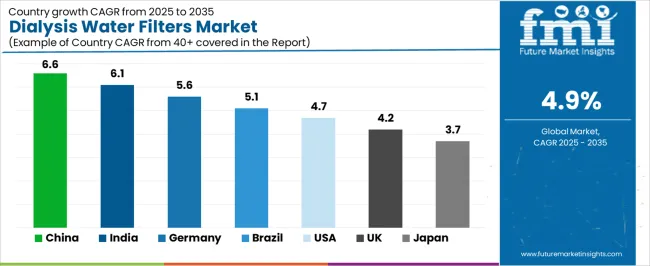
| Country | CAGR (2025-2035) |
|---|---|
| China | 6.6% |
| India | 6.1% |
| Germany | 5.6% |
| Brazil | 5.1% |
| USA | 4.7% |
| UK | 4.2% |
| Japan | 3.7% |
Regional synthesis reveals Asia-Pacific markets leading growth through healthcare infrastructure expansion and chronic disease management development, while European countries maintain steady expansion supported by clinical excellence initiatives and regulatory compliance requirements. North American markets show strong growth driven by healthcare modernization and treatment technology upgrades.
China establishes regional leadership through rapid healthcare system expansion and comprehensive dialysis center development, integrating advanced water filtration systems as standard components in hospital networks and specialized treatment facilities. The country's 6.6% CAGR through 2035 reflects population aging promoting chronic kidney disease prevalence and healthcare infrastructure development that mandate the use of reliable purification systems in dialysis operations. Growth concentrates in major metropolitan areas, including Beijing, Shanghai, and Guangzhou, where healthcare networks showcase integrated water treatment systems that appeal to hospital administrators seeking enhanced clinical quality and international healthcare standards.
Chinese manufacturers are developing innovative dialysis water filter solutions that combine domestic production advantages with international quality specifications, including advanced membrane technologies and automated monitoring capabilities.
Strategic Market Indicators:
The Indian market emphasizes clinical quality applications, including rapid healthcare facility expansion and comprehensive treatment center development that increasingly incorporates dialysis water filters for hospital applications and specialty clinic operations. The country is projected to show a 6.1% CAGR through 2035, driven by massive healthcare modernization activity under national health initiatives and clinical demand for standardized, high-quality purification systems. Indian healthcare facilities prioritize cost-effectiveness with water filters delivering clinical excellence through economical operational usage and reliable performance capabilities.
Technology deployment channels include major hospitals, specialty clinics, and healthcare networks that support high-volume treatment for clinical and emergency applications.
Performance Metrics:
The German market emphasizes advanced water treatment features, including innovative filtration technologies and integration with comprehensive dialysis platforms that manage hospital treatment, outpatient operations, and specialty applications through unified purification systems. The country is projected to show a 5.6% CAGR through 2035, driven by healthcare facility expansion under clinical excellence trends and institutional demand for premium, reliable treatment systems. German healthcare providers prioritize clinical performance with water filters delivering comprehensive treatment support through enhanced purification protection and operational innovation.
Technology deployment channels include major hospital networks, specialty centers, and healthcare systems that support custom development for premium clinical operations.
Performance Metrics:
In São Paulo, Rio de Janeiro, and Brasília, Brazilian healthcare facilities and hospital networks are implementing advanced dialysis water filter systems to enhance treatment capabilities and support clinical excellence that aligns with national healthcare protocols and international standards. The Brazilian market demonstrates sustained growth with a 5.1% CAGR through 2035, driven by healthcare access programs and institutional investments that emphasize reliable purification systems for public and private healthcare applications. Brazilian healthcare facilities are prioritizing water filter systems that provide exceptional clinical performance while maintaining compliance with healthcare standards and minimizing operational complexity, particularly important in hospital dialysis units and specialty treatment center operations.
Market expansion benefits from healthcare modernization programs that mandate enhanced water quality in treatment specifications, creating sustained demand across Brazil's public and private healthcare sectors, where clinical safety and technology reliability represent critical requirements.
Strategic Market Indicators:
The USA market emphasizes cutting-edge dialysis water filter technologies, growing at 4.7% CAGR, with documented clinical excellence in hospital treatment and outpatient applications through integration with existing healthcare infrastructure and quality management systems. The country leverages technological expertise in membrane manufacturing and filtration engineering to maintain market leadership. Healthcare centers, including facilities in California, Texas, and Florida, showcase advanced installations where water filter systems integrate with comprehensive dialysis platforms and treatment protocols to optimize clinical outcomes and operational efficiency.
American healthcare facilities prioritize treatment precision and regulatory compliance in equipment selection, creating demand for premium water filter systems with advanced features, including real-time monitoring and integration with electronic health record systems. The dialysis water filters market benefits from established healthcare infrastructure and willingness to invest in specialized filtration technologies that provide superior clinical performance and regulatory compliance.
Market Intelligence Brief:
The UK market demonstrates sophisticated water treatment deployment, growing at 4.2% CAGR, with established clinical protocols in NHS facilities and private healthcare applications through integration with comprehensive healthcare quality systems and regulatory frameworks. British healthcare facilities prioritize evidence-based treatment and cost-effectiveness in technology selection, supported by clinical research partnerships and quality improvement initiatives. Healthcare centers, including facilities in London, Manchester, and Birmingham, implement advanced water filtration systems that integrate with national healthcare standards and clinical excellence programs.
The dialysis water filters market benefits from established healthcare infrastructure and systematic approach to clinical quality management, creating sustained demand for reliable water filter systems with proven clinical effectiveness and regulatory compliance documentation.
Performance Metrics:
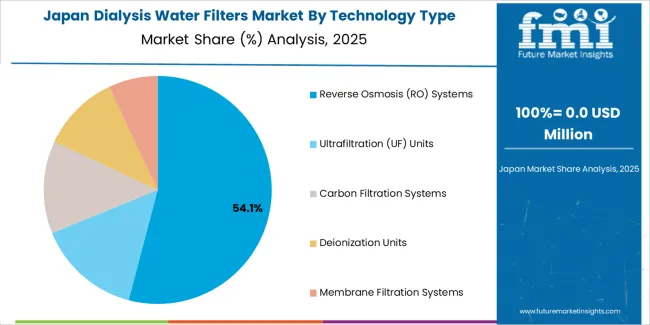
Japan's sophisticated healthcare market demonstrates meticulous dialysis water filter deployment, growing at 3.7% CAGR, with documented clinical excellence in hospital treatment and specialty applications through integration with existing healthcare quality systems and precision manufacturing infrastructure. The country leverages engineering expertise in membrane technology and filtration precision to maintain clinical leadership. Healthcare centers, including Tokyo, Osaka, and Nagoya, showcase advanced installations where water filter systems integrate with comprehensive treatment platforms and quality management systems to optimize clinical outcomes and operational reliability.
Japanese healthcare facilities prioritize treatment precision and technological advancement in equipment selection, creating demand for premium water filter systems with advanced features, including precision monitoring and integration with automated treatment protocols. The dialysis water filters market benefits from established healthcare infrastructure and commitment to invest in specialized filtration technologies that provide superior clinical performance and manufacturing precision.
Market Intelligence Brief:
The dialysis water filters market in Europe is projected to grow from USD 187 million in 2025 to USD 271 million by 2035, registering a CAGR of 3.8% over the forecast period. Germany is expected to maintain its leadership position with a 38.2% market share in 2025, declining slightly to 37.8% by 2035, supported by its healthcare excellence and major clinical centers, including university medical centers in Munich and Berlin.
France follows with a 22.1% share in 2025, projected to reach 22.6% by 2035, driven by comprehensive healthcare programs and hospital modernization initiatives. The United Kingdom holds a 18.7% share in 2025, expected to maintain 19.1% by 2035 through established NHS facilities and private healthcare adoption. Italy commands a 11.8% share, while Spain accounts for 6.9% in 2025. The Rest of Europe region is anticipated to gain momentum, expanding its collective share from 2.3% to 2.9% by 2035, attributed to increasing healthcare development in Eastern European countries and emerging medical infrastructure programs implementing standardized treatment systems.
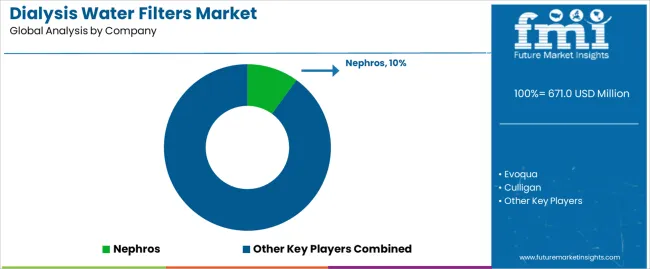
The dialysis water filters market operates with moderate concentration, featuring approximately 15-22 participants, where leading companies control roughly 45-52% of the global market share through established healthcare distribution networks and comprehensive technology portfolio capabilities. Competition emphasizes clinical performance, regulatory compliance, and technological innovation rather than price-based rivalry.Market leaders encompass Nephros, Evoqua, and Culligan, which maintain competitive advantages through extensive filtration engineering expertise, global healthcare distribution networks, and comprehensive clinical support capabilities that create healthcare provider loyalty and support treatment requirements. These companies leverage decades of water treatment experience and ongoing membrane technology investments to develop advanced dialysis water filter systems with exceptional purification performance and clinical reliability.
Specialty challengers include Veolia Water Technologies, Fresenius Medical Care, and AmeriWater, which compete through specialized clinical application focus and advanced technology solutions that appeal to healthcare buyers seeking premium performance formats and custom treatment flexibility. These companies differentiate through clinical excellence emphasis and specialized healthcare market focus.
Market dynamics favor participants that combine superior clinical performance with comprehensive healthcare support, including regulatory compliance assistance and clinical validation capabilities. Competitive pressure intensifies as traditional water treatment manufacturers expand into dialysis filtration systems. At the same time, specialized medical device companies challenge established players through innovative membrane formulations and clinical-focused engineering targeting emerging healthcare segments.
| Item | Value |
|---|---|
| Quantitative Units | USD 671 million |
| Technology Type | Reverse Osmosis (RO) Systems, Ultrafiltration (UF) Units, Carbon Filtration Systems, Deionization Units, Membrane Filtration Systems |
| Application | Hospital, Clinic, Home Dialysis, Ambulatory Surgical Centers, Specialty Treatment Facilities, Others |
| Regions Covered | North America, Europe, Asia Pacific, Latin America, Middle East & Africa |
| Countries Covered | USA, Germany, Japan, China, India, Brazil, UK, and 25+ additional countries |
| Key Companies Profiled | Nephros, Evoqua, Culligan, Veolia Water Technologies, Fresenius Medical Care, AmeriWater |
| Additional Attributes | Dollar sales by technology type and application categories, regional adoption trends across North America, Europe, and Asia-Pacific, competitive landscape with filtration manufacturers and medical device companies, clinical preferences for purification performance and regulatory compliance, integration with dialysis equipment and treatment protocols, innovations in membrane technology and multi-stage filtration systems, and development of specialized clinical solutions with enhanced contaminant removal and monitoring capabilities |
The global dialysis water filters market is estimated to be valued at USD 671.0 million in 2025.
The market size for the dialysis water filters market is projected to reach USD 1,083.0 million by 2035.
The dialysis water filters market is expected to grow at a 4.9% CAGR between 2025 and 2035.
The key product types in dialysis water filters market are reverse osmosis (ro) systems, ultrafiltration (uf) units, carbon filtration systems, deionization units and membrane filtration systems.
In terms of application, hospital segment to command 62.0% share in the dialysis water filters market in 2025.






Full Research Suite comprises of:
Market outlook & trends analysis
Interviews & case studies
Strategic recommendations
Vendor profiles & capabilities analysis
5-year forecasts
8 regions and 60+ country-level data splits
Market segment data splits
12 months of continuous data updates
DELIVERED AS:
PDF EXCEL ONLINE
Dialysis Equipment Industry Analysis in the United States Size and Share Forecast Outlook 2025 to 2035
Dialysis Equipment Market Insights - Growth & Forecast 2025 to 2035
Dialysis Induced Anemia Treatment Market Analysis - Size, Share, & Forecast Outlook 2025 to 2035
Dialysis Device and Concentrates Market Growth - Trends & Forecast 2025 to 2035
Hemodialysis and Peritoneal Dialysis Market Analysis – Size, Share & Forecast 2024-2034
Home Dialysis Systems Market Size and Share Forecast Outlook 2025 to 2035
Continuous Ambulatory Peritoneal Dialysis Bags Market Size and Share Forecast Outlook 2025 to 2035
Water Leak Sensors Market Size and Share Forecast Outlook 2025 to 2035
Water-soluble Packaging Market Size and Share Forecast Outlook 2025 to 2035
Water Leak Detection System for Server Rooms and Data Centers Market Size and Share Forecast Outlook 2025 to 2035
Water and Wastewater Treatment Equipment Market Size and Share Forecast Outlook 2025 to 2035
Water Treatment Market Size and Share Forecast Outlook 2025 to 2035
Water Underfloor Heating Thermostat Market Size and Share Forecast Outlook 2025 to 2035
Water Activity Meter Market Size and Share Forecast Outlook 2025 to 2035
Water Leakage Tester Market Size and Share Forecast Outlook 2025 to 2035
Waterstops Market Size and Share Forecast Outlook 2025 to 2035
Water-miscible Metalworking Oil Market Size and Share Forecast Outlook 2025 to 2035
Waterborne Polyurethane Dispersions Market Size and Share Forecast Outlook 2025 to 2035
Water Surface Conditioning Equipment Market Size and Share Forecast Outlook 2025 to 2035
Water-based Inks Market Size and Share Forecast Outlook 2025 to 2035

Thank you!
You will receive an email from our Business Development Manager. Please be sure to check your SPAM/JUNK folder too.
Chat With
MaRIA